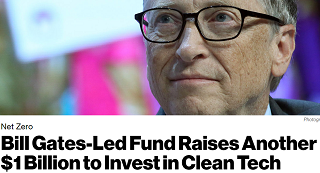A Few Words on Breakthrough Energy Ventures

Created in 2016, BEV began funding startups just as the second wave of clean-tech investments was gaining momentum. Since then, interest in the sector has exploded. VC money flowing into startups that can help cut emissions has soared to $16 billion in 2019 from $400 million in 2013, a 40-times increase, according to a PwC report published last year.
The first clean-tech boom was a disappointment. VCs lost more than half the $25 billion invested between 2006 and 2011. The financial crisis compounded the losses, but experts believe there were bigger problems with the underlying investment philosophy. First, VCs were looking to replicate the success they had seen in internet startups, expecting returns from clean-tech investments in less than five years. Second, the types of technologies they invested in were mostly limited to renewable electricity, biofuels and electric vehicles—all of which depended heavily on government regulations to grow.
In particular, the ventures that VCs made their fortunes with in the tech boom were based on a COGS (cost of goods sold) of next to nothing, as it’s 99% software; the case with renewable energy is the precise opposite. Almost all of it is solar panels, inverters, grid-ties, wind turbine blades and nacelles, geothermal drill bits, algae “racetracks,” and water turbines. The stuff that isn’t hardware includes other costly items like growing, transporting, and processing biomass, drilling holes through the toughest rock on the planet, etc.
The development of new renewable energy technologies means things like prototyping a wind turbine that’s 80% the height of the Empire State Building; the development of a new app means finding a nerd with an IQ of 170 to write code, and paying him with company stock that might become worth a mint.
The fortunes that derived from the cellphone app years made billions of people’s lives more convenient. Cleantech won’t be as quick and easy, but will result in a civilization that isn’t choking itself to death.
BEV learned from that failure. It launched a “patient” fund that would run for 20 years, instead of expecting returns in just five years?
Well, I suppose that’s good, but what if we’re simply stretching our failure out over a longer period of time. Ray Lane of Kleiner-Perkins, stratospheric VC firm in Palo Alto (Silicon Valley), told me, “If you’re going to fail, do so quickly. Learn from your mistakes, and move on with that knowledge.”
It also pursued a larger set of technologies, including agriculture, buildings, transportation, and manufacturing. Profit remains the ultimate objective, but BEV set another criteria: companies needed to show a path to scaling up that would cut at least 500 billion metric tons of annual CO₂ emissions—about 1% of global emissions.
That’s why BEV relies on a team that consists of academics, entrepreneurs, former government officials, and bankers, along with VC investors. Their mission goes beyond judging an idea and the people behind it to rigorously evaluate the feasibility and potential of new technologies.
In all, I have to say that all this sounds great. Best of luck.
